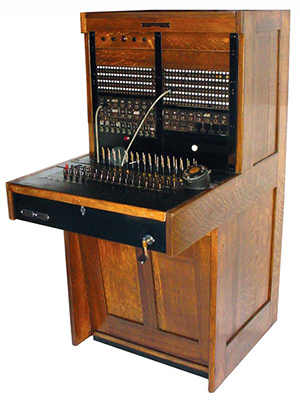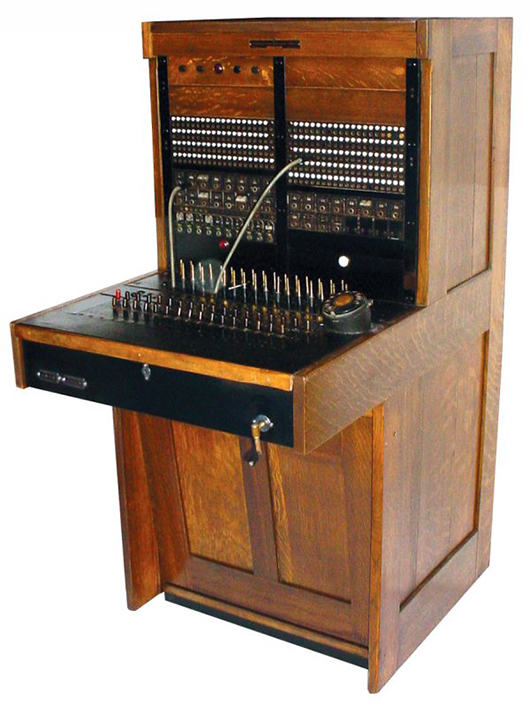
It was Dec. 7, 1941, and the switchboard at the C&P Telephone building here began blinking like the taillights on W.Va. Route 705 after a night game at Milan Puskar Stadium.
America was at war, and people didn’t know what to do. So they called the operator.
Each one of those red lights on the switchboard of that tan brick building at 214 Monroe St., represented somebody who was afraid, angry or fretful over the fate of a loved one who may have been in harm’s way in Pearl Harbor, Hawaii.
The late Nettie Layman, who died in 2010 at 106, was a direct descendent of West Virginia’s founding family, the Morgans – which was a good thing to be known for, she said.
But she made her name first as a switchboard operator, and she told that Pearl Harbor story a lot over the years, including to The Dominion Post, in a profile eight years ago.
She and her fellow operators did the only thing they could do, she said. They took each call, one right after the other.
There really wasn’t time to commiserate, she said, even though she and her co-workers wanted to.
“We didn’t know what to tell people,” she said then. “No one of us knew anything either.”
Layman worked 39 years as chief long-distance operator in that building, which today isn’t exactly what it used to be.
In many ways, though, it’s still what it was.
Today, the ground floor of the building now owned and operated by Frontier is home to a collection of America’s communication past.
Ornate, wood-carved switchboards. Vintage telephones, in basic black. Ancient-history phone booths.
All this phone-ephemera is bundled into a collection known simply as the Telephone Museum.
It’s open mainly by appointment for tours run by former employees who stayed in their vocation through corporate hangups and person-to-person calls, with no additional charges for direct dialing, rotary dialing, avocado Princess phones, bag phones and those whizbang smartphones, too.
Admission is free.
A lot of tours are made up of Cub Scout troops, elementary school classes, and the like, and those groups are the most entertaining, Russ Wrachford laughed.
The handheld communication device set, he said, can’t get a buzz on what telephones used to be.
Including the relatively recent history of the first mass-produced cellphones of the 1980s.
You know: Those walkie talkie-looking things with the telescoping antennas.
“There was a little boy in a group here the other day,” said Wrachford, who worked on telephone lines and communication networks while in Korea in the military, and then came home to log 36 years with the phone company.
“He’s looking at one of those ‘bag’ phones, and he says, ‘OK, now how you gonna get that in your pocket?’”
And when Wrachford talks about today’s digital communications, where the voice on the other end of your smartphone is sampled 8,000 times a second – yep – then the collective facial expression of the group goes just like the “perplexed” emoticon you tagged onto each of your texts from the corporate meeting last month.
“Things change,” he said. “Technology.”
You don’t have to put a call out to Sue Merrill to get her to agree.
Merrill, a genial great-grandmother who put in as many years at the phone company as Wrachford, began her career as a switchboard operator in 1966 – she still sounds like a switchboard operator, in fact, which was an important component to the job.
“Oh, yes,” she said, “you were always being monitored. You were always told to put that ‘smile’ in your voice.”
Merrill doesn’t mind change one bit, she said. She held a variety of jobs in the phone company and was always going for training to keep up with new technology.
She just wants people to remember where telecommunications came from, and just how hard those switchboard operators worked.
As said, each red light was a call, and each call had a hierarchy of communication and manual actions the operator had to deliver.
Merrill demonstrated, with a one-sided re-enactment of what a typical call might sound like on her shift.
“Operator, may I help you? What number are you calling from? Is this a collect call, or person-to-person?”
Cords to make the connection had to be inserted into the corresponding jack on the switchboard that lit, signifying the call.
Levers were flipped, numbers were noted, and all that information was recorded (by hand) onto a card that was stamped with a time clock-type device to record the minutes of the call for the customer’s bill.
Here’s where the operator had to dial into some dexterity: You only had five seconds to do all of the above.
“That’s was all you got,” Merrill said. “If you didn’t, there was a supervisor behind you, yelling ‘Get that call!’”
Don’t hang up yet: “You have to remember,” she said, “when I started in ’66, we still had eight party lines in Morgantown.”
Just like Mayberry.
On an overcast morning at the museum late last month, Wrachford and Merrill happily worked through the displays, while Merrill’s great-granddaughter, Rilyn, 2, romped in and out among the switchboards.
The switchboards never fail to elicit a “whoa” or two from the local phone-aficionados who attend.
That’s because the museum has a direct line as it were, to the telephone history of Monongalia and Preston counties.
The 1907 switchboard panel from the Hotel Morgan, for instance.
And the 1939 edition from Morgantown’s C&P building on Fayette Street.
Like most people who worked in telecommunications, Merrill and Wrachford love seeing it depicted wrong in movies and TV.
The 1960s CBS sitcom, Green Acres, for example, Wrachford said.
That’s the one starring Eddie Albert as Oliver Wendell Douglas, an upscale Manhattan attorney who moves with his glamorous wife to the country, so he can become a gentleman farmer.
A running gag featured Albert shimmying up the telephone pole next to his ramshackle farm. He can only call from the top of the pole, employing an actual “butt-in” phone used by workers in the field.
It was named that, since the phone guy could use it to do just that on any working line.
The rotary dial of the phone is at the top of the earpiece.
In the show, however, Albert talks into it upside down.
“The director wanted to show the dial,” Wrachford said. “You wouldn’t be able to see it if he used it the right way. You’ll have to watch a clip of it sometime.”
Punch it up on your smartphone, he said.
For more information on the museum, call Merrill, at 304-983-2463; or Wrachford, at 304-983-2627
___
Information from: The Dominion Post, http://www.dominionpost.com
Copyright 2014 Associated Press. All rights reserved. This material may not be published, broadcast, rewritten, or redistributed.
AP-WF-11-05-14 1449GMT
ADDITIONAL IMAGE OF NOTE


